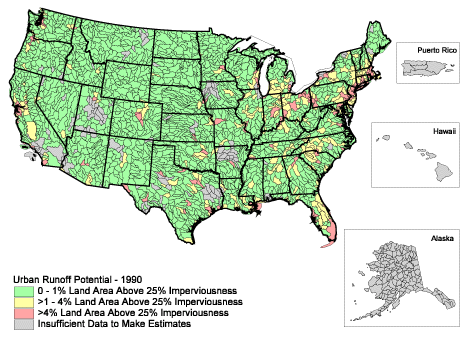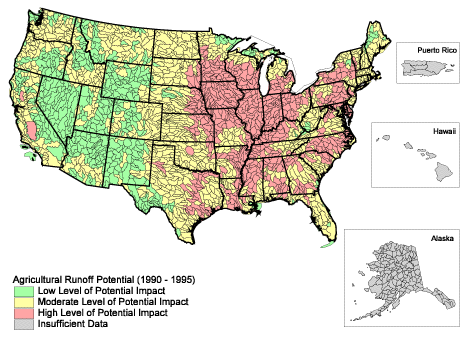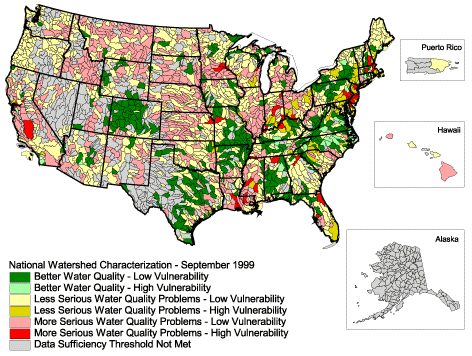|
Built and Urban Environments:
 In
the United States about 75% of the people live in cities or urban environments.
These urban environments are not without their environmental problems and
issues. Traffic, transportation, and congestion significantly impact
the quality of the urban environment. Traffic and transportation contribute
to air pollution problems that are exacerbated by industry, electrical
generation, and commercial and residential heating and cooling requirements.
Topography, climate, and atmospheric processes contribute to these air
quality problems by transporting, concentrating, dispersing, and removing
pollutants from the atmosphere. Urban noise may be deafening and is influenced
by traffic patterns and densities, buildings, and the location of green
spaces. Waste removal and disposal have become major issues for city
dwellers and urban planners as landfills become full. Solid, hazardous
and toxic waste disposal, unsafe waste storage, and illegal dumping become
issues of concern for city planners. The growth and development of
urban environments, as well as surrounding land use patterns impact the
quality of drinking water and sewage treatment systems. Urban sprawl
and land use planning and zoning have become major issues for cities and
towns, impacting both the quality of life and the quality of the environment.
The demand for increased green spaces and urban forestry creates planning
and zoning conflicts with commercial and industrial developers. Built
environments create microclimates, influence and concentrate human impacts
on the environment, and expose people to indoor air pollutants: radon,
molds, and toxins. The home environment is filled with potential
hazardous materials and wastes: antifreeze, motor oil, brake fluid, cleaning
solvents, bleach and ammonia, oven cleaners, garden pesticides and herbicides,
lawn fertilizers, paints, stains, and varnishes (to name a few).
Many of these materials make their way into the waste stream (the flow
of waste) eventually ending up in landfills where they pose threats to
surface and groundwater quality, eventually affecting the quality of drinking
water. In
the United States about 75% of the people live in cities or urban environments.
These urban environments are not without their environmental problems and
issues. Traffic, transportation, and congestion significantly impact
the quality of the urban environment. Traffic and transportation contribute
to air pollution problems that are exacerbated by industry, electrical
generation, and commercial and residential heating and cooling requirements.
Topography, climate, and atmospheric processes contribute to these air
quality problems by transporting, concentrating, dispersing, and removing
pollutants from the atmosphere. Urban noise may be deafening and is influenced
by traffic patterns and densities, buildings, and the location of green
spaces. Waste removal and disposal have become major issues for city
dwellers and urban planners as landfills become full. Solid, hazardous
and toxic waste disposal, unsafe waste storage, and illegal dumping become
issues of concern for city planners. The growth and development of
urban environments, as well as surrounding land use patterns impact the
quality of drinking water and sewage treatment systems. Urban sprawl
and land use planning and zoning have become major issues for cities and
towns, impacting both the quality of life and the quality of the environment.
The demand for increased green spaces and urban forestry creates planning
and zoning conflicts with commercial and industrial developers. Built
environments create microclimates, influence and concentrate human impacts
on the environment, and expose people to indoor air pollutants: radon,
molds, and toxins. The home environment is filled with potential
hazardous materials and wastes: antifreeze, motor oil, brake fluid, cleaning
solvents, bleach and ammonia, oven cleaners, garden pesticides and herbicides,
lawn fertilizers, paints, stains, and varnishes (to name a few).
Many of these materials make their way into the waste stream (the flow
of waste) eventually ending up in landfills where they pose threats to
surface and groundwater quality, eventually affecting the quality of drinking
water.
|
|
Rural Environments:
 Although
the majority of people in the United States live in cities, their activities
greatly impact rural environments. Weather patterns transport particulate
matter and air pollutants to rural environments; the waste stream (the
flow of waste) often ends in landfills located in rural environments, raising
issues about solid, hazardous, and toxic waste disposal and concerns about
surface, groundwater, and drinking water quality. Further, cities impact
the quality of rural environments through parking lot and road runoff (non-point
source pollution) and waste water discharge (point source pollution) into
rivers and streams. Sprawling cities consume land and change land
use patterns impacting both the environment and the culture of the local
community. Rural environments provide food to the world, yet impact
surface and groundwater quality through agricultural runoff--animal waste,
pesticides, herbicides, and fertilizers. Soil erosion from fields
also impacts the quality of our streams and lakes, as well as the land's
ability to produce crops and food for the world. Soil, as an ecosystem,
is as essential to life as water. Ecologically inappropriate farming
and grazing practices can devastate the soil ecology, greatly impacting
the ability to produce crops. Although
the majority of people in the United States live in cities, their activities
greatly impact rural environments. Weather patterns transport particulate
matter and air pollutants to rural environments; the waste stream (the
flow of waste) often ends in landfills located in rural environments, raising
issues about solid, hazardous, and toxic waste disposal and concerns about
surface, groundwater, and drinking water quality. Further, cities impact
the quality of rural environments through parking lot and road runoff (non-point
source pollution) and waste water discharge (point source pollution) into
rivers and streams. Sprawling cities consume land and change land
use patterns impacting both the environment and the culture of the local
community. Rural environments provide food to the world, yet impact
surface and groundwater quality through agricultural runoff--animal waste,
pesticides, herbicides, and fertilizers. Soil erosion from fields
also impacts the quality of our streams and lakes, as well as the land's
ability to produce crops and food for the world. Soil, as an ecosystem,
is as essential to life as water. Ecologically inappropriate farming
and grazing practices can devastate the soil ecology, greatly impacting
the ability to produce crops.
|
|
Water and Watersheds:
 Focus
is on environmental concepts, issues, and research surrounding the management
of wetlands, streams, and watersheds. In addition to their ecological
significance, wetlands play important and often unappreciated roles in
flood reduction, groundwater recharge, water quality protection, and recreation.
The destruction of wetlands has numerous environmental impacts, however,
once drained, former wetland areas can become highly productive agricultural
areas or prime real estate for development. Participants will learn about
wetlands concepts and issues through the Celery Bog case study, a local
wetland impacted by agricultural, residential, commercial, industrial,
and recreational land use, and the focus of much local debate and community
activism. Focus
is on environmental concepts, issues, and research surrounding the management
of wetlands, streams, and watersheds. In addition to their ecological
significance, wetlands play important and often unappreciated roles in
flood reduction, groundwater recharge, water quality protection, and recreation.
The destruction of wetlands has numerous environmental impacts, however,
once drained, former wetland areas can become highly productive agricultural
areas or prime real estate for development. Participants will learn about
wetlands concepts and issues through the Celery Bog case study, a local
wetland impacted by agricultural, residential, commercial, industrial,
and recreational land use, and the focus of much local debate and community
activism.
Burnett Creek in Battle Ground introduces participants to stream ecology
and water quality issues within a watershed. Like wetlands, streams
are located within a watershed. A watershed is an area of land that
drains into a particular stream, like Burnett Creek. A creek may
flow into a river located in a larger watershed. For example, Burnett
Creek flows into the Wabash River. Thus, large watersheds are comprised
of subwatersheds. In the Lafayette area, the water quality of the
Wabash River is impacted not only by water that drains from the surrounding
land, but by water that flows into it from other streams like Burnett Creek.
The water quality and ecology of Burnett Creek is influenced by the degree
of point source and nonpoint source pollution that drains into it from
the surrounding land within the watershed. Point source pollution
is from a known source or location such as a pipe or sewage treatment facility.
Nonpoint source pollution is picked up by rainwater that flows over land
as it drains into a stream. Examples of nonpoint source pollution
are debris from construction sites, fertilizers from lawns and agricultural
fields, and run off from parking lots. |
| Water is essential for life on earth, yet 2% is freshwater
and only a small portion is available for human use. Thus, it is
crucial to understand the sources of water and the uses and management
of water (see Source Water Condition Map below). It is easy
to forget that our drinking water doesn't just come from a tap or a bottle.
The water that we drink comes from streams, rivers, lakes, or from ground
water wells that tap underground aquifers. Most of the drinking water
from these sources is treated before it's poured into our glasses.
However, treatment is often expensive for water providers and for the customers
drinking that water. The costs of treatment can be reduced or avoided
by ensuring that the sources of drinking water are safe from contamination.
Ground water is a vital national resource that is used for myriad purposes.
It is used for public and domestic water supply systems, for irrigation
and livestock watering, and for industrial, commercial, mining, and thermoelectric
power production purposes. In many parts of the nation, ground water
serves as the only reliable source of drinking and irrigation water.
Unfortunately, this vital resource is vulnerable to contamination, and
ground water contaminant problems are being reported throughout the country. |